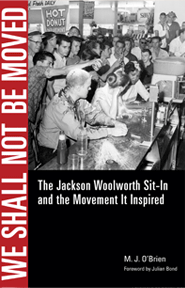University Press of Mississippi

Is available and can be purchased or ordered wherever you buy new books, Amazon, Barnes & Noble, and University Press of Mississippi.
Thanks in advance.
FOLLOW US
HISTORY
Once in a great while, an image captures the essence of an era. Three people–one black, two white–sit at a lunch counter while a horde of cigarette smoking hot shots pour catsup, sugar, and other counter condiments on the sitters’ heads and down their backs. The image strikes a chord for all who lived through those turbulent times of a changing America. And for those too young to have endured that period, it evokes an era, not that long ago, when the ordinary act of getting a cup of coffee with a friend of another race could spark a riot.
“Michael O’Brien has written a detailed history and fascinating study of one of the iconic moments of the modern civil rights movement and the powerful effect it had. . . . Readers will enjoy this behind the scenes look at an important event in movement history.”
— Julian Bond Chairman Emeritus NAACP

